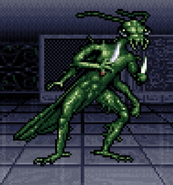The thri-kreen (pronounced: /θraɪˈkrin/ thry-KREEN[15]) were an insectoid monstrous humanoid race that primarily lived in the Shaar. The thri-kreen were a race of nomads and hunters. They were also known as mantis warriors and sometimes called "tri-kreen".[5][3][8][4][9]
Description[]
A thri-kreen resembled a giant praying mantis, bipedal and standing 4.5–7 feet (1.4–2.1 meters) high and weighing 100–375 pounds (45–170 kilograms); a full-grown adult averaged at 6 feet (1.8 meters) and 200 pounds (90 kilograms). They had exoskeletons over their entire bodies.[3][4] They had six limbs protruding from their thorax: two for walking and four for use as arms, ending in four-fingered claw-like hands capable of tool- and weapon-use. Their insectoid heads had two black, multi-faceted compound eyes; two small antennae sprouting from the top; and a complex jaw structure with large sharp mandibles.[5][3][4][8] It was extremely difficult to distinguish the males and females.[5]
The carapace of a thri-kreen was typically a sandy yellow in hue, but could vary from a sandy brown to a pale green color, as best suited the environment. This enabled thri-kreen to blend in with the dry savannas and grasslands they dwelled in.[5][3][4][8]
Thri-kreen wore little to no clothing or armor. Instead, they wore only simple leather belts, harnesses, or slings to hold their food, equipment, and weaponry, and only as much as they needed. They did not make or wear any kind of adornments.[5][3][4]
Abilities[]
Thri-kreen had superior physical abilities compared to a human, with high strength and great agility. They were faster on their feet, and naturally and supremely good at jumping. They were quick enough to deflect or dodge an incoming projectile. Their carapace was naturally armored, being tough and resistant to impact, and its sandy color helped them hide in sandy or barren landscapes. Thri-kreen typically grew to be skilled in their senses, hiding, jumping, climbing, and balancing.[5][3][4]
A thri-kreen's four claws and a bite from its mandibles were dangerous natural weapons. They secreted a paralyzing poison from their mouths, sufficient for a single venomous bite per day. This could hamper a victim's agility, or cause paralysis for several minutes.[5][3][4]
Thri-kreen were naturally psionic beings, possessing psionic energy and knowing innately a number of powers. A thri-kreen could manifest the powers chameleon and know direction and location thrice each per day, and greater concealing amorpha and metaphysical claw once each per day.[3][4]
They could see in the dark through darkvision, and did not sleep at all, making them immune to sleep spells and the like.[3][4]
Combat[]
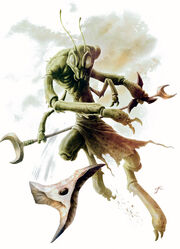
A thri-kreen wielding a gythka and hurling a chatkcha.
When hunting prey, thri-kreen used their natural and unnatural camouflage abilities to get close and observe. They always spared the time to prepare, using their psionic powers to boost their defensive and offensive capability. They then quickly closed the distance with their speed and jumping prowess, but if the fight went against them, they retreated just as quickly, using their camouflage to hide once more.[3][4]
In melee, the mantis warriors were whirlwinds of violence, preferring their four claws and venomous bites, but also wielding strange weapons. The thri-kreen primarily fought with two types of weapons unique to their kind: the gythka, a double-ended, crescent-headed polearm; and the chatkcha, a crystalline throwing wedge. With four arms, a thri-kreen could wield two gythkas or throw up to four chatkchas at a time. As exotic as these weapons were, they came naturally to trained mantis warriors.[5][3][4]
Personality[]
Thri-kreen had no clear or definable personalities as humans would know them. No emotions could be discerned from their insectoid faces or their patterns of behavior, though rapid twitching of their antennae or mandibles indicated agitation.[3] Acting spontaneously, they were unpredictable and always of chaotic alignment, showing no inclination toward good or evil. These traits made them utterly alien and inscrutable to other races, and folk unfamiliar with them regarded them as savage and brutal monsters.[3][4]
In fact, thri-kreen simply viewed themselves and other beings in terms of the relationship between predator and prey. They saw themselves as noble hunters,[4] and were wholly focused on survival and the basic needs of existence, a life in which the weak died and the strong survived. They were not cruel or evil if they had no need to be, but nor did they go out of their way to aid others if they did not have to.[3] By instinct, they saw humanoid beings as food first and as trading partners or allies second.[5]
Their alien thought patterns made it hard for them to understand the advanced concepts or sophisticated social rules of other races.[3][4] They lacked ideas of devotion, honor, or loyalty, but they respected skill and strength and recognized the convenience of working with talented hunting companions. They maintained no traditions, and saw no benefit in the traditions of others.[3] They valued little that humanoids made.[5]
Relations[]
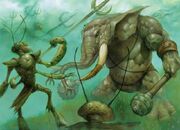
Thri-kreen and loxo waging a territorial dispute on the Shaar.
Predictably, it was also very difficult for thri-kreen to deal with others,[4] and they were hard to negotiate with.[5][3][4] They neither avoided nor sought out other races, but merely existed alongside them, sharing territory without conflict. They appreciated folk who lived off the land, respectfully hunted prey, and cared for the environment. Farmers and city-dwellers were seen as "not-hunters", not worthy of attention nor hostility.[3][4] However, they would treat with others—the Krakk't tribe sent one of their number to the Hill of Memories each year to meet with human, centaur, and wemic representatives of the Shining Plains, where they discussed issues.[16]
However, those who overhunted, despoiled the land, or otherwise wasted natural resources, such as gnolls, orcs, and others, were seen as dangers to be driven off or destroyed. A thri-kreen pack would attack without pause or consideration for their own safety. They typically did not attack without provocation, however.[3][4] Nevertheless, there would always be some vicious examples—as in any species—who would attack and kill strangers without pause or thought, purely for the sake of it.[17] Either way, when they did attack, it was without mercy or guilt.[14]
Humanoid realms sometimes made alliances with thri-kreen neighbors that encouraged the mantis warriors to oppose folk from a rival realm or assist in some activity, if they could be persuaded. Some collectors valued thri-kreen harnesses and their exotic weapons. Some trophy-hunters even mounted whole thri-kreen exoskeletons for display, even having them magically animated like undead skeletons. A thri-kreen's head could even be hollowed out and worn as a helmet or mask.[5]
Society[]
Thri-kreen mated in the spring. The females dug egg chambers and laid clutches of up to 120 eggs, before reburying and abandoning it. The eggs hatched in mid-summer; the larvae looked like miniature adult thri-kreen. They survived on instinct alone, discovering hunting and tool-making skills and how to survive, but 90% of larvae perished[5] before reaching adulthood after only 5 or 6 summers[5][3][4] Thri-kreen were short-lived; if they survived their harsh lives, they could be considered middle-aged at 12 or 16, old by 18 to 20, and truly venerable at 25. No thri-kreen lived past 35 by natural means.[3][4]
Thri-kreen were distinctly not social in nature.[5] Each thri-kreen developed deep personal attachments to only a small handful of other thri-kreen, their clutch-mates. They would defend these companions at all costs, even at the cost of their own lives. All creatures outside this small band were viewed as strangers and enemies, though a wandering thri-kreen didn't advertise such beliefs for the sake of peace.[4] They formed small and independent packs, almost always of their clutch-mates,[5][3] but sometimes lone young thri-kreen or survivors of failed packs would join existing packs or find each other and establish new packs.[5] Rarely, a few packs would ally to combine their strength when they faced a more dangerous threat.[3]
They had very nomadic lifestyles, with packs journeying great distances within their extensive territories over their relatively short lifespans. Permanent settlements of thri-kreen were completely unheard of.[3][4]
Thri-kreen packs spent their days foraging and hunting for the food and other supplies they need to survive.[3] They could survive on relatively little food and water, and were carnivorous, pursuing a variety of creatures as prey.[5] Thri-kreen tribes like the Krakk't typically hunted rabbits, horses (which they considered a delicacy), and other herd beasts.[9][18] They also especially enjoyed the taste of elves.[5][18][5] Leftover meat they dried and saved to eat later, but when times were tough, they would eat carrion or even cannibalize each other, even their young.[5]
Sometimes—usually requested by a thri-kreen leader, but not always—a thri-kreen left their pack to explore lands outside their territory, on the basis that the information gained would be useful for the pack's survival. Such lone thri-kreen often fell in with others who wandered the land, simply in order to survive. In the process, they learned their ways and bonded with them, adopting them as new clutch-mates. Most became caravan guards across the plains, but rarely a wandering thri-kreen joined with an adventuring party.[3][4]
Culture[]
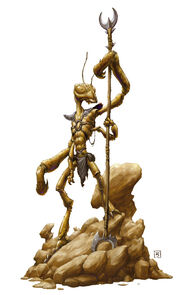
A thri-kreen on look-out.
Thri-kreen were not religious[17] and had no established faith, nor gods of their own. Instead, they preferred druidic traditions of nature worship and thri-kreen druids served as spiritual leaders for their kind.[3][4] Thri-kreen druids were usually attuned to nature deities like Malar and Silvanus, those with portfolios of hunting and natural resources. A few thri-kreen however, likely influenced by humanoid neighbors like the Shaarans, saw the benefits in Akadi or Tempus, and became their clerics.[3]
They placed little value in possessions. What few treasures or trinkets they had were kept for their usefulness or decorative purposes.[5]
Language[]
Thri-kreen had their own language—simply called Thri-Kreen—made up of whistles and clicks and snaps of their mandibles. Typical thri-kreen names were Chak-tha, Chit'al, Drik-chkit, Gulnik, Kacht-ta, Kat'chka, Kiktul, Klaktuk, Krik, Pak'cha, Pik-ik-cha, Pok, Ptekwe, Tak-tha, Tal'tich, Tilnak, and Tik-tik; there were no gendered names and no surnames.[3][4]
Thri-kreen whose packs ranged close to humanoid civilizations often picked up a little of their languages too, usually Common, but Elven, Giant, Gnoll, Goblin, and Halfling were all possible. Those who dwelled in the Shaar typically also picked up Shaaran.[3][4][14]
Thri-kreen lands[]
Thri-kreen preferred climates that were dry and warm, but could manage in temperate conditions. They also favored arid and open landscapes that provided places where they could easily camouflage themselves, such as against dry grass, sand dunes, and rock. Thus they could be found in deserts, grasslands, plains, savannas, and scrublands, places many other folk would see as uninhabitable.[5][3][4] When they did rest, they dug lairs that were little more than bare and lightless holes in the ground.[5]
Their best known territory was perhaps in the Eastern Shaar,[3][14][8] where thri-kreen controlled the hills and lowlands a short distance north of the Toadsquat Mountains. They occasionally ventured further north, but to avoid confrontations with humans, they rarely went as far as the Council Hills.[8] Their nomadic population was relatively small, divided into a number of packs that trekked the open grasslands and plains, hunting and following the migrating herds.[3][14][8] Thri-kreen were especially well suited for the hot, dry environment of the Shaar, and here they flourished.[8] They were known to be an untiring, well-disciplined, and fearless group, well-armed with gythkas and chatkchas and potions of cure light wounds.[14]
Because of this, the thri-kreen were dominant in their territory, but they ignored other races within it and did not attack unless provoked or their resources were threatened. Otherwise, they remained reclusive and tried to avoid confrontation if they could. In return, however, most other races of the Shaar feared them and also steered clear of them. Centaurs and wemics of the Shaar liked them not and stayed away, while the loxo, also seen as alien by their neighbors, better accepted the thri-kreen and trade with them from time to time.[3][14][8] Some Shaaran human tribes got on well with both loxo and thri-kreen, others less so, according to how close their territories were, but the Shaarans only interacted as much as the thri-kreen permitted them.[19]
The small Krakk't tribe of thri-kreen dwelt in the Rushing Hills and ranged into the Shining Plains east of the Vilhon Reach.[9][10]
Thri-kreen were also sighted on the more barren parts of the plains north of the Lake of Steam or in ruins found there.[11]
To the east, thri-kreen were very rarely sighted in the central steppe of the Hordelands, and in the Quoya and Raurin deserts.[12]
Thri-kreen also lived in the badlands and harsh deserts of the far northwest of Maztica. The Azuposi people told fanciful stories of these mantis warriors, claiming among other things that they mined precious gems and metals—and devoured these riches for food![13]
History[]
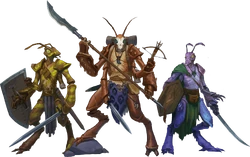
A trio of spelljamming thri-kreen adventurers.
The thri-kreen were an ancient race, predating the races of both humans and mind flayers by millions of years.[20] Thousands of years before the Standing Stone (1 DR),[7][20] the thri-kreen were spread all over the crystal spheres, a time when they were known as the People of the Celestial Mantis.[7][20] The ancient poetry of the thri-kreen contained some of the most detailed creation myths of any known race, and these myths included references to an enigmatic race called the Juna[20] or the Lost Gods.[7]
The People of the Celestial Mantis were strongly religious, worshiping the Mantis God of the Eternal Lotus. The tenets and philosophy of this major sect of thri-kreen religion at that time were largely incomprehensible and alien to other races, yet the People of the Celestial Mantis had a strong belief in the need to spread their religion among the crystal spheres. When other races did not convert to the faith of the spacefaring thri-kreen, they used their spelljamming navies to force the infidels to convert.[7]
From 715 DR, the three cities of the Shining Plains—Assam, Lheshayl, and Ormath—spent the next three centuries in skirmishes and minor battles with the thri-kreen and centaurs of the plains, before they learned to live in peace.[21]
In the mid-to-late 14th century DR, one of the People of the Celestial Mantis, named Tiktikik, was discovered by a group of adventurers traveling in the phlogiston. The mantis warrior's body had been preserved for some forty centuries in the flow. Tiktikik desired to be returned to his own people, and his request was granted.[7] Tiktikik, after discovering a lost apocrypha of his people entitled Lyric of the Eternal Lotus, came to believe himself to be his people's new holy leader. Within only four months, Tiktikik had convinced the spacefaring thri-kreen tribes to unite under his leadership and once again spread their rediscovered religion to wildspace.[22]
Tiktikik's fleet surrounded the Rock of Bral and demanded its conversion to the faith of the Mantis God of the Eternal Lotus, prompting even Prince Andru to abandon his palace. Ultimately, the Rock was saved by the diplomatic actions of the same group of adventurers who had earlier rescued Tiktikik, as they happened to be on the Rock at the time when the thri-kreen flotilla arrived. The group showed Tiktikik a more ancient manuscript of the Lyric of the Eternal Lotus, convincing him that the later edition had had additions from later editors who were not inspired.[22]
Appendix[]
Gallery[]
Appearances[]
Adventures
Novels & Short Stories
Into the Void
Video Games
Card Games
Miniatures
Organized Play & Licensed Adventures
Further Reading[]
- Bruce R. Cordell (2001-03-30). More Psionic Monsters (Zipped PDF). Web Enhancement for Psionics Handbook. Wizards of the Coast. Archived from the original on 2016-11-01. Retrieved on 2018-09-10.
- Tim Beach, Dori Jean Hein (1995). Thri-Kreen of Athas. Edited by Jon Pickens. (TSR, Inc.), p. 84. ISBN 0-7869-0125-X.
External Links[]
Disclaimer: The views expressed in the following links do not necessarily represent the views of the editors of this wiki, nor does any lore presented necessarily adhere to established canon.
 Thri-kreen article at the Dark Sun Wiki, a wiki for the Dark Sun campaign setting.
Thri-kreen article at the Dark Sun Wiki, a wiki for the Dark Sun campaign setting. Thri-kreen article at the Eberron Wiki, a wiki for the Eberron campaign setting.
Thri-kreen article at the Eberron Wiki, a wiki for the Eberron campaign setting. Thri-kreen article at Wikipedia, The Free Encyclopedia.
Thri-kreen article at Wikipedia, The Free Encyclopedia.
References[]
- ↑ 1.0 1.1 1.2 Mike Mearls, Jeremy Crawford, Christopher Perkins (2014-09-30). Monster Manual 5th edition. Edited by Scott Fitzgerald Gray. (Wizards of the Coast), p. 288. ISBN 978-0786965614.
- ↑ Mike Mearls, Greg Bilsland, Robert J. Schwalb (June 2010). Monster Manual 3 4th edition. Edited by Greg Bilsland, et al. (Wizards of the Coast), p. 193. ISBN 978-0-7869-5490-2.
- ↑ 3.00 3.01 3.02 3.03 3.04 3.05 3.06 3.07 3.08 3.09 3.10 3.11 3.12 3.13 3.14 3.15 3.16 3.17 3.18 3.19 3.20 3.21 3.22 3.23 3.24 3.25 3.26 3.27 3.28 3.29 3.30 3.31 3.32 3.33 3.34 3.35 3.36 3.37 3.38 3.39 3.40 3.41 3.42 3.43 3.44 Thomas Reid (October 2004). Shining South. (Wizards of the Coast), pp. 15–17, 72–73. ISBN 0-7869-3492-1.
- ↑ 4.00 4.01 4.02 4.03 4.04 4.05 4.06 4.07 4.08 4.09 4.10 4.11 4.12 4.13 4.14 4.15 4.16 4.17 4.18 4.19 4.20 4.21 4.22 4.23 4.24 4.25 4.26 4.27 4.28 4.29 4.30 4.31 4.32 4.33 4.34 4.35 4.36 4.37 Bruce R. Cordell (April 2004). Expanded Psionics Handbook. (Wizards of the Coast), pp. 14–15, 213–214. ISBN 0-7869-3301-1.
- ↑ 5.00 5.01 5.02 5.03 5.04 5.05 5.06 5.07 5.08 5.09 5.10 5.11 5.12 5.13 5.14 5.15 5.16 5.17 5.18 5.19 5.20 5.21 5.22 5.23 5.24 David Cook, Steve Winter, and Jon Pickens (1989). Monstrous Compendium Volume Three Forgotten Realms Appendix (MC3). (TSR, Inc). ISBN 0-88038-769-6.
- ↑ Gary Gygax (August 1983). Monster Manual II 1st edition. (TSR, Inc), p. 119. ISBN 0-88038-031-4.
- ↑ 7.0 7.1 7.2 7.3 7.4 7.5 Nigel Findley (1990). Skull & Crossbows. (TSR, Inc.), pp. 42–43. ISBN 0-88038-845-5.
- ↑ 8.00 8.01 8.02 8.03 8.04 8.05 8.06 8.07 8.08 8.09 8.10 Thomas Reid (October 2004). Shining South. (Wizards of the Coast), p. 166. ISBN 0-7869-3492-1.
- ↑ 9.0 9.1 9.2 9.3 Jim Butler (1996). The Vilhon Reach (Dungeon Master's Guide). (TSR, Inc), p. 47. ISBN 0-7869-0400-3.
- ↑ 10.0 10.1 Jim Butler (1996). The Vilhon Reach (Player's Guide). (TSR, Inc), p. 21. ISBN 0-7869-0400-3.
- ↑ 11.0 11.1 Steven E. Schend, Dale Donovan (September 1998). Empires of the Shining Sea. Edited by Julia Martin. (TSR, Inc.), p. 126. ISBN 0-7869-1237-5.
- ↑ 12.0 12.1 David Cook (August 1990). “Volume II”. In Steve Winter ed. The Horde (TSR, Inc.), pp. 115, 126. ISBN 0-88038-868-4.
- ↑ 13.0 13.1 John Nephew and Jonathan Tweet (April 1992). City of Gold. (TSR, Inc), p. 78. ISBN 978-1560763222.
- ↑ 14.0 14.1 14.2 14.3 14.4 14.5 14.6 Thomas Reid (October 2004). Shining South. (Wizards of the Coast), p. 19. ISBN 0-7869-3492-1.
- ↑ Frank Mentzer (January 1985). “Ay pronunseeAYshun gyd”. In Kim Mohan ed. Dragon #93 (TSR, Inc.), p. 30.
- ↑ Jim Butler (1996). The Vilhon Reach (Dungeon Master's Guide). (TSR, Inc), p. 44. ISBN 0-7869-0400-3.
- ↑ 17.0 17.1 Thomas Reid (October 2004). Shining South. (Wizards of the Coast), p. 169. ISBN 0-7869-3492-1.
- ↑ 18.0 18.1 Jim Butler (1996). The Vilhon Reach (Player's Guide). (TSR, Inc), p. 18. ISBN 0-7869-0400-3.
- ↑ Thomas Reid (October 2004). Shining South. (Wizards of the Coast), p. 13. ISBN 0-7869-3492-1.
- ↑ 20.0 20.1 20.2 20.3 Nigel Findley (September 1991). Into the Void. (TSR, Inc.), p. 65. ISBN ISBN 1-56076-154-7.
- ↑ Jim Butler (1996). The Vilhon Reach (Player's Guide). (TSR, Inc), p. 7. ISBN 0-7869-0400-3.
- ↑ 22.0 22.1 Nigel Findley (1990). Skull & Crossbows. (TSR, Inc.), pp. 49–53. ISBN 0-88038-845-5.


